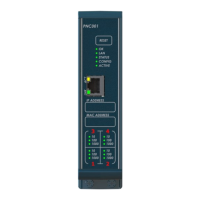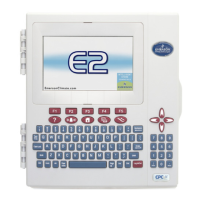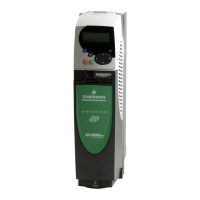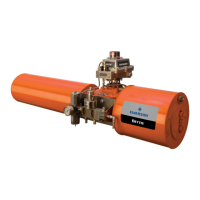Safety
Information
Product
Information
Mechanical
Installation
Electrical
Installation
Getting
Started
Basic
parameters
Running
the motor
Optimization
SMARTCARD
operation
PC tools
Advanced
parameters
Technical
Data
Diagnostics
UL Listing
Information
Affinity User Guide 219
Issue Number: 5 www.controltechniques.com
If PID is used to control the motor output via Menu 1 and sleep mode is
enabled, then the drive will automatically stop the motor when the output
drops below the sleep/wake threshold. The feedback may then fall
causing the output and hence the feedback to rise again. Setting
Pr 14.28 and Pr 14.29 to non zero values results in the value in Pr 14.28
being added to the PID reference for a length of time defined in Pr 14.29
when the drive attempts to enter sleep mode.. This will reduce the
frequency of the transitions into sleep mode. Pr 14.30 indicates when
the boost system is enabled.
Software version V1.03.00 and earlier
If Pr 14.58 is set a value greater than zero, then the following algorithm
is applied to PID 1 feedback.
Square root function output = Sign(Feedback) x 100.00% x 14.58 x
v(|Feedback| / 100.00%)
where Sign(Feedback) is 1 if the feedback is positive or -1 is the
feedback is negative.
If Pr 14.58 is set to 0.000 then this feature is disabled and the feedback
remains unchanged.
Software version V1.04.00 and later
Pr 14.58 allows scaling to be applied to the combined feedback signal
from PID controller 1 and PID controller 2 after the square root function
has been applied.
The square root functions in the feedback paths are enabled or disabled
with Pr 14.60, Pr 14.61 and Pr 14.62.
When the square root function is enabled, the following algorithm is
applied to the feedback.
Square root function output = Sign(Feedback) x 100.00% x
v(|Feedback| / 100.00%)
where Sign(Feedback) is 1 if the feedback is positive or -1 is the
feedback is negative.
Single setpoint, single feedback (Pr 14.59 = 0 or 1)
The two PID controllers operate independently. The feedback for PID2 is
always from the PID2 feedback input. PID1 feedback can select one of
two sensors as shown in the table below.
14.24 PID 1 feedback scaling
14.54 PID 2 feedback scaling
RW Uni US
Ú
0.000 to 4.000
Ö
1.000
14.25 PID 1 digital reference
14.55 PID 2 digital reference
RW Bi NC
Ú
±100.00 %
Ö
0.00
14.26 PID 1 digital feedback
14.55 PID 2 digital feedback
RW Bi NC
Ú
±100.00 %
Ö
0.00
14.27 PID 1 optional enable source parameter 2
RW Uni PT US
Ú
0.00 to 50.99
Ö
0.00
14.28 PID 1 pre-sleep boost level
RW Uni US
Ú
0.00 to 100.00 %
Ö
0.00
14.29 Maximum boost time
RW Uni US
Ú
0.0 to 250.0 s
Ö
0.0
14.30 PID 1 pre-sleep boost level enable
RO Bit NC PT
Ú
OFF (0) or On (1)
Ö
14.38 PID 2 enable
RW Uni US
Ú
0 to 2
Ö
0
Parameter
value
PID enable state
0
PID 2 disabled; output is zero and integrator reset to
zero
1 PID 2 enabled
2 PID 2 enable state follows PID 1 enable state
14.58 Square root scaling
RW Uni US
0.000 to 4.000 1.000
14.58 PID 1 feedback output scaling
RW Uni US
0.000 to 4.000 0.000
14.60 PID 1 Square root enable
14.61 PID 2 Square root enable
RW Bit US
OFF (0) or On (1) OFF (0)
14.62 Combined PID square root enable
RW Uni US
OFF (0) or On (1) OFF (0)
14.59 PID mode selector
RW Uni US
0 to 7 0
Parameter 14.59 Final PID1 feedback
0 PID1 feedback
1 PID2 feedback
